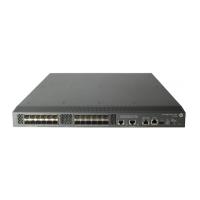323
Default level
2: System level
Parameters
group-name: Specifies the name of the peer group, which is a case-sensitive string of 1 to 47 characters.
ip-address: Specifies the IP address of the peer.
Examples
# In BGP-VPNv4 subaddress family view, configure the device to exclude private AS numbers from the
BGP updates to be sent to the peer group test.
<Sysname> system-view
[Sysname] bgp 100
[Sysname-bgp] ipv4-family vpnv4
[Sysname-bgp-af-vpnv4] peer test public-as-only
peer reflect-client
Description
Use the peer reflect-client command to configure the local device to be an RR and set a peer or peer
group as the client of the RR.
Use the undo peer reflect-client command to remove the configuration.
By default, no RR or RR client is configured.
The BGP view, BGP-VPNv4 subaddress family view, and BGP-VPNv6 subaddress family view support the
peer reflect-client command. If you configure this command in BGP view, you configure the local device
to reflect public network routes. If you configure this command in BGP-VPNv4 subaddress family view or
BGP-VPNv6 subaddress family view, you configure the local device to reflect private network routes. For
more information about BGP view, see the Layer 3—IP Routing Command Reference.
Syntax
peer { group-name | ip-address } reflect-client
undo peer { group-name | ip-address } reflect-client
View
BGP-VPNv4 subaddress family view, BGP-L2VPN address family view, VPLS address family view
Default level
2: System level
Parameters
group-name: Specifies the name of the peer group, which is a case-sensitive string of 1 to 47 characters.
ip-address: Specifies the IP address of the peer.
Examples
# In BGP-VPNv4 subaddress family view, configure the local device as an RR and the peer group test as
the client of the RR.
<Sysname> system-view
[Sysname] bgp 100
[Sysname-bgp] ipv4-family vpnv4

